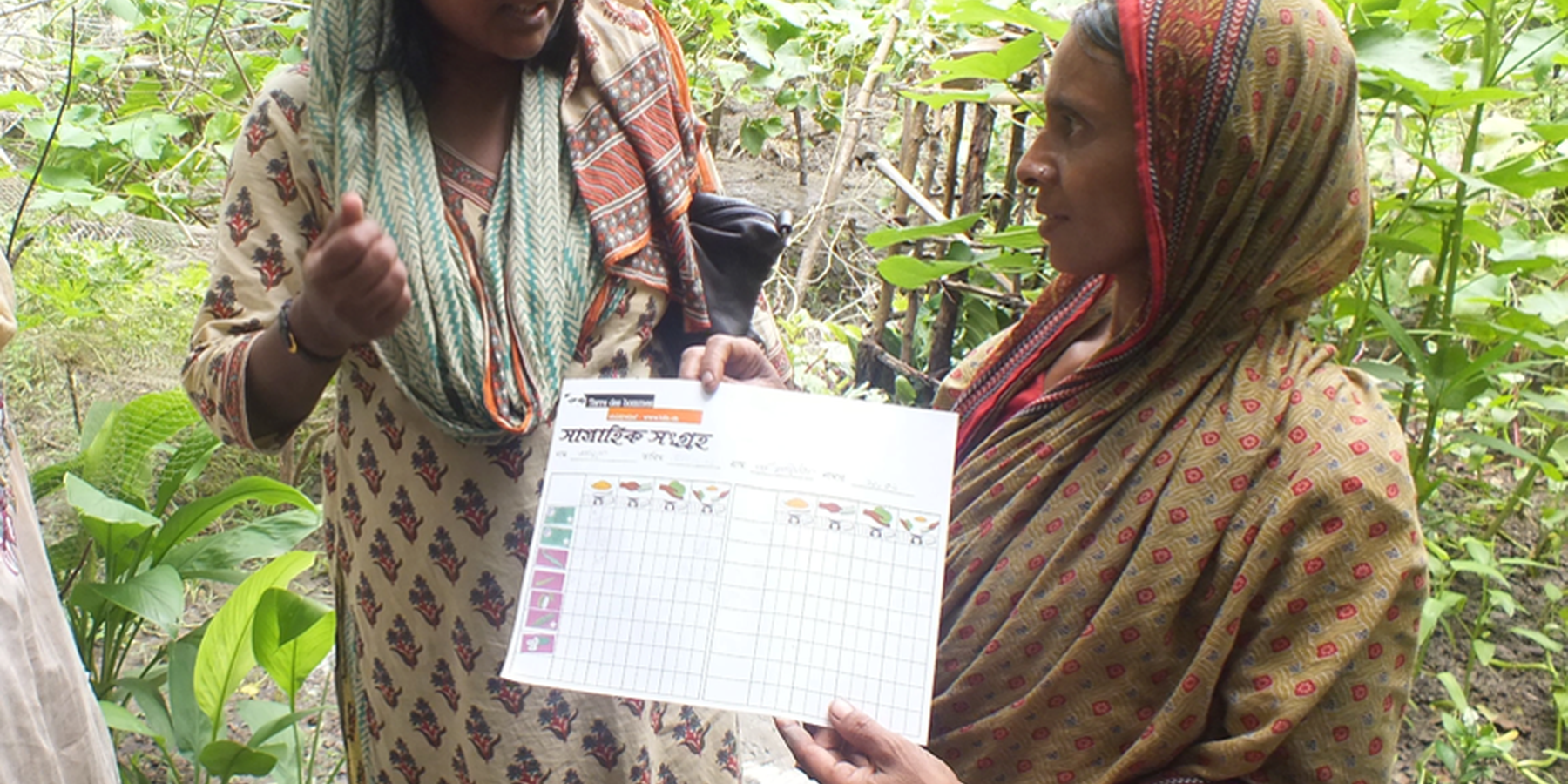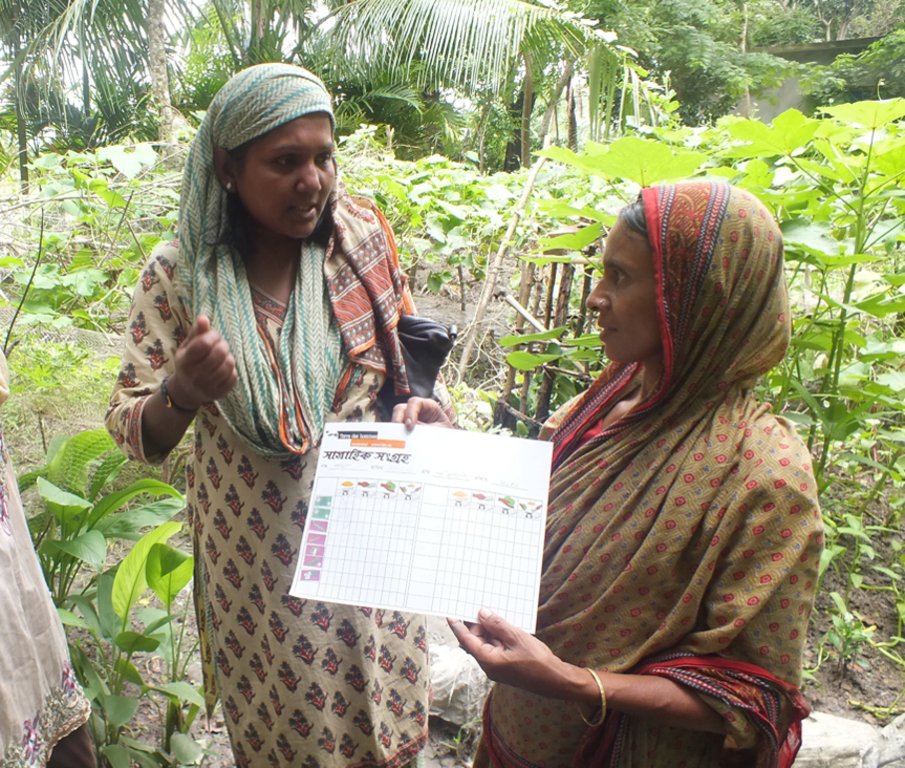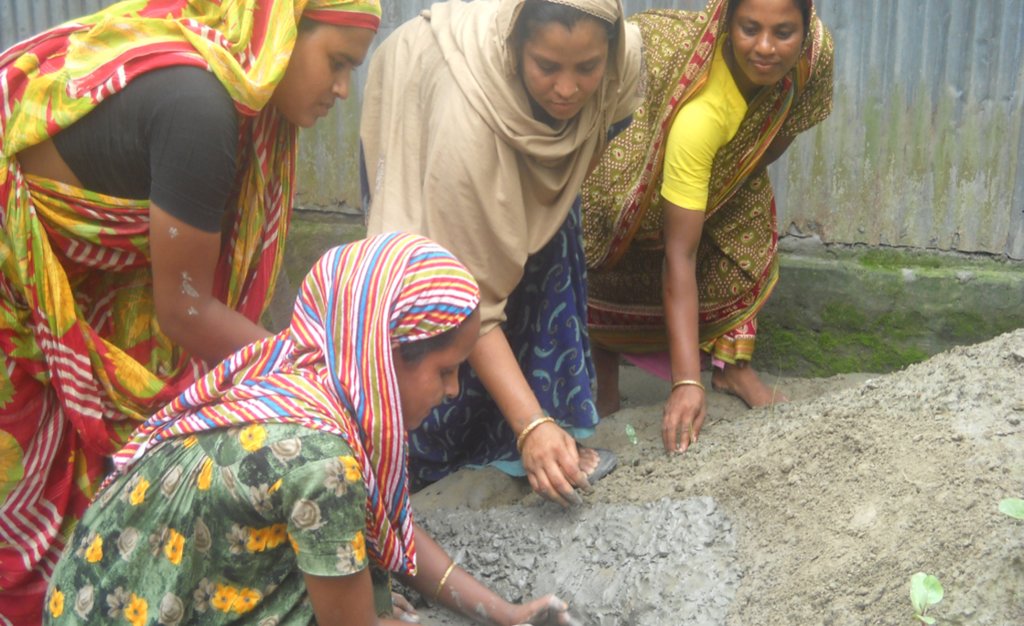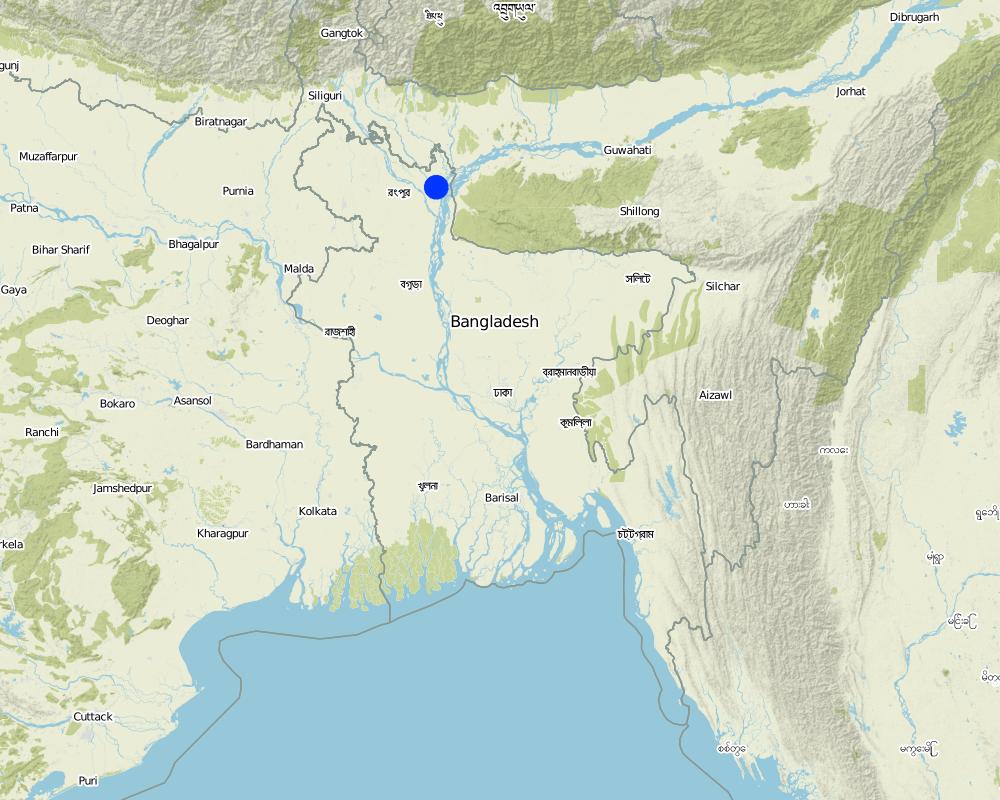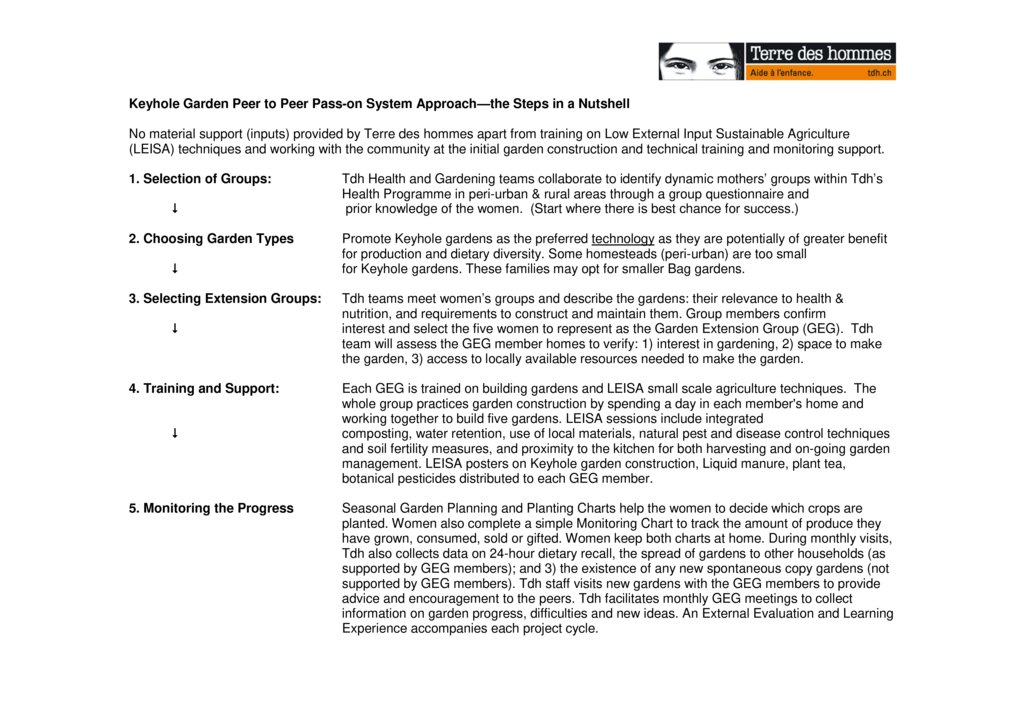Peer to Peer Pass-on Approach with Women [ប្រទេសបង់ក្លាដែស]
- ការបង្កើត៖
- បច្ចុប្បន្នភាព
- អ្នកចងក្រង៖ John Brogan
- អ្នកកែសម្រួល៖ Shahid Kamal
- អ្នកត្រួតពិនិត្យច្រើនទៀត៖ Alexandra Gavilano, Boris Orlowsky
approaches_784 - ប្រទេសបង់ក្លាដែស
ពិនិត្យមើលគ្រប់ផ្នែក
ពង្រីកមើលទាំងអស់ បង្រួមទាំងអស់1. ព័ត៌មានទូទៅ
1.2 ព័ត៌មានលម្អិតពីបុគ្គលសំខាន់ៗ និងស្ថាប័នដែលចូលរួមក្នុងការវាយតម្លៃ និងចងក្រងឯកសារនៃវិធីសាស្ត្រផ្សព្វផ្សាយ
បុគ្គលសំខាន់ម្នាក់ (ច្រើននាក់)
អ្នកជំនាញឯកទេស SLM:
Brogan John
john.brogan@tdh.ch
Terre des hommes
15 Avenue Montchoisi 1006 Lausanne
ប្រទេសស្វ៊ីស
WASH/DRR Advisor:
អ្នកជំនាញឯកទេស SLM:
Taylor Sheila
Sheila.Taylor@sendacow.org
Send a Cow UK
ឈ្មោះគម្រោងដែលបានចងក្រងឯកសារ/ វាយតម្លៃលើវិធីសាស្ត្រផ្សព្វផ្សាយ (បើទាក់ទង)
Book project: where people and their land are safer - A Compendium of Good Practices in Disaster Risk Reduction (DRR) (where people and their land are safer)ឈ្មោះអង្គភាពមួយ (ច្រើន) ដែលបានចងក្រងឯកសារ/ វាយតម្លៃលើវិធីសាស្ត្រផ្សព្វផ្សាយ (បើទាក់ទង)
Terre des Hommes (Terre des Hommes) - ប្រទេសស្វ៊ីស1.3 លក្ខខណ្ឌទាក់ទងទៅនឹងការប្រើប្រាស់ទិន្នន័យដែលបានចងក្រងតាមរយៈវ៉ូខេត
តើពេលណាដែលទិន្នន័យបានចងក្រង (នៅទីវាល)?
14/08/2013
អ្នកចងក្រង និង(បុគ្គលសំខាន់ៗ)យល់ព្រមទទួលយកនូវលក្ខខណ្ឌនានាទាក់ទងទៅនឹងការប្រើប្រាស់ទិន្នន័យដែលបានចងក្រងតាមរយៈ វ៉ូខេត:
បាទ/ចា៎
1.4 ការយោងមួយ (ច្រើន) ទៅលើ (កម្រង) បញ្ជីសំណួរនៃបច្ចេកទេស SLM
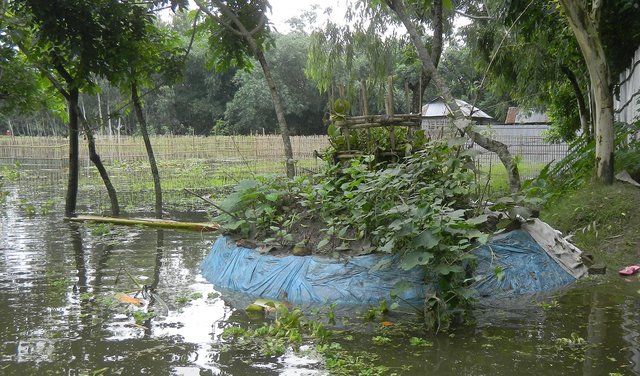
Keyhole Garden [ប្រទេសបង់ក្លាដែស]
The Keyhole Garden model of homestead vegetable cultivation enhances the resilience of families living in areas with climate-related hazards, such as flooding and drought. Keyhole gardens have been shown to increase vegetable production in all seasons, thereby improving household food autonomy and dietary diversity.
- អ្នកចងក្រង៖ John Brogan
2. ការពណ៌នាអំពីវិធីសាស្ត្រផ្សព្វផ្សាយ SLM
2.1 ពណ៌នាសង្ខេបខ្លីពីវិធីសាស្ត្រផ្សព្វផ្សាយ
Terre des hommes and Greendots introduced the Peer to Peer pass-on system to enable women's groups in Bangladesh to spread the Keyhole Garden technique within their communities with the aim of enabling year-round homestead vegetable production despite the risk of flooding and tidal surge.
2.2 ពណ៌នាលម្អិតពិវិធីសាស្ត្រផ្សព្វផ្សាយ
ពណ៌នាលម្អិតពិវិធីសាស្ត្រផ្សព្វផ្សាយ:
Keyhole Gardens, a type of small, productive homestead vegetable garden based on Low External Input Sustainable Agriculture (LEISA) techniques, have been used in various African countries for over 15 years and shown to increase the availability of food and dietary diversity (FAO). They were developed by gardeners and small-scale farmers (with the support of Send a Cow UK) to suit different situations, such as the cold, dry winters of Lesotho, the small backyards of Rwanda, and the humid heat of central Uganda. To improve year-round homestead nutritional self-sufficiency for vulnerable families in South Asia (where rates of acute malnutrition in young children regularly cross emergency thresholds), Keyhole gardens were adapted by Terre des hommes (Tdh) and Greendots to the conditions of river basin and coastal areas of Bangladesh (and eventually to India's Sundarbuns) . As a component to Tdh's maternal neonatal and child health (MNCH) programme, the technology is intended to support year-round homestead gardening despite weather extremes (flooding, tidal surge, cyclones).
To promote spontaneous replication of the Keyhole gardening in the local communities, the programme initiated a Peer to Peer Pass-on system within 40 mothers' groups (having a total membership of nearly 800 women). Each mothers' group selected five representatives (200 women) to form a Garden Extension Group (GEG) and participate in the first round of training with the understanding that they would share knowledge with other women in the MNCH programme and the surrounding community. The project team trained each GEG on building gardens and LEISA small scale agriculture techniques (including integrated composting, water retention, use of local materials, natural pest and disease control techniques and soil fertility measures, proximity to the kitchen for optimal management and harvesting). GEG group members practiced garden construction by working together to build gardens at the homes of all five members. All 200 initial gardens were monitored by Tdh extension workers on a weekly basis. Tdh verified output, use and the capacity of gardens to withstand monsoon conditions, and the extent of the of the Peer to Peer Pass-on experience.
See the Chart in Section 3.3 for more information.
2.3 រូបភាពនៃវិធីសាស្ត្រផ្សព្វផ្សាយ
2.4 វីឌីអូនៃវិធីសាស្ត្រផ្សព្វផ្សាយ
ការពណ៌នាសង្ខេប:
https://www.youtube.com/watch?v=WmDgGa0XIO8
BBC Media Action Bangladesh produced a segment on its "Amrai Pari" programme for the Bangladeshi public (in Bangla language) describing women's use and promotion of the Keyhole Garden technique in coastal communities on the Bay of Bengal.
កាលបរិច្ឆេទ:
09/11/2014
ទីតាំង:
Barguna District, Barisal Division, Bangladesh
ឈ្មោះអ្នកថតវីឌីអូ:
BBC Media Action
2.5 ប្រទេស/តំបន់/ទីតាំងកន្លែង ដែលវិធីសាស្ត្រផ្សព្វផ្សាយត្រូវបានអនុវត្តន៍
ប្រទេស:
ប្រទេសបង់ក្លាដែស
តំបន់/រដ្ឋ/ខេត្ត:
Kurigram District / Rajshahi Division and Barguna District / Barisal Division
បញ្ជាក់បន្ថែមពីលក្ខណៈនៃទីតាំង:
Kurigram municipality (Kurigram District), Patharghata Union (Barguna District)
Map
×2.6 កាលបរិច្ឆេទនៃការចាប់ផ្តើម និងបញ្ចប់នៃវិធីសាស្រ្តផ្សព្វផ្សាយនេះ
សូមបញ្ជាក់ឆ្នាំដែលបានបង្កើតឡើង:
2012
2.7 ប្រភេទនៃវិធីសាស្ត្រផ្សព្វផ្សាយ
- ផ្អែកលើគម្រោង/កម្មវិធី
2.8 គោលបំណង/ទិសដៅសំខាន់នៃវិធីសាស្ត្រផ្សព្វផ្សាយ
The main aims of the approach are to involve women by building their capacity and peer network to replicate the Keyhole gardening approach within their communities.
The main objective of the approach is that that families, led by women 1) garden year-round with LEISA techniques, 2) increase the quantity and diversity of their homestead vegetable production and 3) verify that the DRR garden design reduces the consequences of flooding and tidal surge.
2.9 លក្ខខណ្ឌអនុញ្ញាត ឬរារាំងការអនុវត្តន៍បច្ចេកទេសដែលស្ថិតនៅក្រោមវិធីសាស្រ្តផ្សព្វផ្សាយ
សង្គម/វប្បធម៌/ និងតម្លៃនៃសាសនា
- អំណោយផល
Acceptance of women's groups, existing mothers' groups within Health programme
ចំណេះដឹងស្តីពី SLM និងការទទួលបានការគាំទ្រផ្នែកបច្ចេកទេស
- អំណោយផល
The Approach calls for capacity building on LEISA techniques (knowledge on SLM) via the Peer to Peer Pass-on system to spread the DRR-designed gardens.
3. ការចូលរួម និងតួនាទីរបស់ភាគីពាក់ព័ន្ធ
3.1 អ្នកពាក់ព័ន្ធដែលបានចូលរួមក្នុងវិធីសាស្ត្រផ្សព្វផ្សាយ និងតួនាទីរបស់ពួកគេ
- អ្នកប្រើប្រាស់ដីក្នុងតំបន់/សហគមន៍
Homestead land users (women)
Building the gardens: learning and eventually training their peers
- អង្គការសហគមន៍មូលដ្ឋាន
Mothers' groups
Garden extension groups to share the Keyhole Garden techniques within the scope of their maternal neonatal & child health & activities
- អ្នកឯកទេសគ្រប់គ្រងដីប្រកបដោយចីរភាព/ទីប្រឹក្សាបច្ចេកទេសកសិកម្ម
Greendots (www.greendots.ch)
Technical support with design of the approach: Daniel Varadi and Sheila Taylor.
- អង្គការអន្តរជាតិ
Terre des hommes (international NGO)
Project implementing Agency, direct connection with women's groups within its MNCH Programme via Dr. Sultana Al-Amin (Gardening Specialist).
ប្រសិនមានភាគីពាក់ព័ន្ធច្រើនចូលរួមសូមចង្អុលបង្ហាញភ្នាក់ងារដែលនាំមុខគេ:
Terre des hommes
3.2 ការចូលរួមរបស់អ្នកប្រើប្រាស់ដីក្នុងតំបន់/ សហគមន៍ក្នុងតំបន់ក្នុងដំណាក់កាលផ្សេងគ្នានៃវិធីសាស្រ្តផ្សព្វផ្សាយ
| ការចូលរួមរបស់អ្នកប្រើប្រាស់ដីក្នុងតំបន់/សហគមន៍ក្នុងតំបន់ | សូមបញ្ជាក់នរណាត្រូវបានចូលរួម ព្រមទាំងពណ៌នាសកម្មភាពទាំងនោះ | |
|---|---|---|
| ការចាប់ផ្តើម/ការលើកទឹកចិត្ត | អសកម្ម | Terre des hommes and Greendots working through existing women's MNCH nutrition groups, requested groups to nominate five women to receive the training. |
| ការរៀបចំផែនការ | អសកម្ម | As with all village-level activities, Terre des hommes works with a community volunteer in each village to plan the training and group interventions. |
| ការអនុវត្តន៍ | គំនិតផ្តួចផ្តើមដោយខ្ឡួនឯង | Once the women were trained, they were free to honor their commitments to train other women. |
| ការត្រួតពិនិត្យ និងវាយតម្លៃ | អន្តរកម្ម | Self planning and monitoring tools were introduced to the women--who decided whether to use them. Tdh provided monthly support visits to help interested women to update the planning and monitoring documents as needed, and to collect data. |
3.3 គំនូសបំព្រួញ (ប្រសិនបើមាន)
3.4 ការសម្រេចចិត្តលើការជ្រើសរើសបច្ចេកទេស SLM
សូមបញ្ជាក់តើអ្នកណាជាអ្នកបានសម្រេចចិត្តក្នុងការជ្រើសរើសបច្ចេកទេសដើម្បីយកមកអនុវត្តន៍:
- អ្នកប្រើប្រាស់ដី ដោយមានការគាំទ្រពីអ្នកជំនាញឯកទេស SLM
ចូរពន្យល់:
The Keyhole garden technique was introduced by Tdh, and went through informal adaptation and development with farmers and women's groups so that the final design was chosen by the communities and reflected the construction preferences and innovations of the users.
សូមបញ្ជាក់ តើការសម្រេចធ្វើឡើងដោយផ្អែកលើអ្វីជាមូលដ្ឋាន:
- បទពិសោធន៍ និងគំនិតផ្ទាល់ខ្លួន(ពុំមានចងក្រងជាឯកសារ)
4. ជំនួយបច្ចេកទេស ការកសាងសមត្ថភាព និងការគ្រប់គ្រងចំណេះដឹង
4.1 ការកសាងសមត្ថភាព/ បណ្តុះបណ្តាល
តើវគ្គបណ្តុះបណ្តាលបានផ្តល់ឱ្យអ្នកប្រើប្រាស់ដី/អ្នកពាក់ព័ន្ធផ្សេងៗទៀតដែរឬទេ?
បាទ/ចា៎
សូមបញ្ជាក់តើអ្នកណាត្រូវបានបណ្តុះបណ្តាល:
- អ្នកប្រើប្រាស់ដី
- បុគ្គលិកចុះទីវាល/អ្នកផ្តល់ប្រឹក្សាយោបល់
ទម្រង់នៃការបណ្តុះបណ្តាល:
- អនុវត្តន៍ជាមួយការងារ
- ពីកសិករទីកសិករ
4.2 សេវាផ្តល់ប្រឹក្សាយោបល់
តើអ្នកប្រើប្រាស់ដីបានទទួលនូវសេវាផ្តល់ប្រឹក្សាដែរ ឬទេ?
បាទ/ចា៎
សូមបញ្ជាក់ប្រសិនបើសេវាកម្មប្រឹក្សាយោបល់ត្រូវបានផ្តល់ឱ្យ:
- នៅលើដីរបស់អ្នកប្រើប្រាស់ដី
4.3 ការពង្រឹងសមត្ថភាពស្ថាប័ន (ការអភិរឌ្ឍន៍អង្គភាព)
តើស្ថាប័នទាំងអស់ត្រូវបានបង្កើតឡើង ឬពង្រឹងសមត្ថភាពតាមរយៈវិធីសាស្ត្រផ្សព្វផ្សាយដែរ ឬទេ?
- ទេ
4.4 ការត្រួតពិនិត្យ និងវាយតម្លៃ
តើការត្រួតពិនិត្យ និងវាយតម្លៃគឺជាផ្នែកមួយនៃវិធីសាស្ត្រដែរឬទេ?
បាទ/ចា៎
4.5 ការស្រាវជ្រាវ
តើការស្រាវជ្រាវ គឺជាផ្នែកមួយនៃវិធីសាស្រ្តដែរឬទេ?
ទេ
5. ថវិកា និងសម្ភារៈឧបត្ថម្ភពីខាងក្រៅ
5.1 ថវិកាប្រចាំឆ្នាំសម្រាប់ផ្សព្វផ្សាយ SLM
ប្រសិនបើចំនួនពិតប្រាកដនៃថវិកាប្រចាំឆ្នាំមិនត្រូវបានដឹងច្បាស់ សូមប្រាប់ពីចន្លោះនៃថវិកានោះ:
- 2,000-10,000
5.2 ការគាំទ្រផ្នែកហិរញ្ញវត្ថុ / សម្ភារៈដែលបានផ្តល់ទៅឱ្យអ្នកប្រើប្រាស់ដី
តើអ្នកប្រើប្រាស់ដីបានទទួលការគាំទ្រផ្នែកហិរញ្ញវត្ថ/សម្ភារៈសម្រាប់ការអនុវត្តន៍បច្ចេកទេសដែរឬទេ:
ទេ
5.3 សូមបញ្ជាក់ពីធាតុចូលត្រូវបានផ្តល់បដិភាគ (រួមទាំងកម្លាំងពលកម្ម)
- គ្មាន
ប្រសិនបើកម្លាំងពលកម្មធ្វើដោយអ្នកប្រើប្រាស់ដី តើវាជាធាតុចូលដ៏សំខាន់មួយដែរ ឬទេ:
- ដោយស្ម័គ្រចិត្ត
5.4 ឥណទាន
តើឥណទានដែលបានផ្តល់នៅក្រោមវិធីសាស្ត្រផ្សព្វផ្សាយសម្រាប់សកម្មភាព SLM នេះយ៉ាងដូចម្តេច?
ទេ
5.5 ការលើកទឹកចិត្ត ឬវិធីសាស្ត្រដ៏ទៃទៀត
តើមានការលើកទឹកចិត្តផ្សេងទៀត ឬឧបករណ៍ប្រើប្រាស់ដើម្បីលើកកម្ពស់ការអនុវត្តន៍បច្ចេកទេស SLM?
ទេ
6. ការវិភាគរកផលប៉ះពាល់ និងសេចក្តីសន្និដ្ឋាន
6.1 ផលប៉ះពាល់នៃវិធីសាស្ត្រផ្សព្វផ្សាយ
តើវិធីសាស្ត្រផ្សព្វផ្សាយបានផ្តល់សិទ្ធិអំណាចដល់អ្នកប្រើប្រាស់ដី ធ្វើឱ្យប្រសើរឡើងនូវការចួលរួមអ្នកពាក់ព័ន្ធ?
- ទេ
- បាទ/ច៎ា បន្តិចបន្តួច
- បាទ/ច៎ា ជាមធ្យម
- បាទ/ច៎ា បានខ្លាំង
តើវិធីសាស្ត្រផ្សព្វផ្សាយជួយអ្នកប្រើប្រាស់ដីដើម្បីអនុវត្តន៍ និងថែទាំបច្ចេកទេស SLM?
- ទេ
- បាទ/ច៎ា បន្តិចបន្តួច
- បាទ/ច៎ា ជាមធ្យម
- បាទ/ច៎ា បានខ្លាំង
តើវិធីសាស្រ្តផ្សព្វផ្សាយនេះធ្វើឱ្យប្រសើរឡើងនូវការសម្របសម្រួលនិងការអនុវត្តចំណាយរបស់ SLMមានប្រសិទ្ធិភាពបែបណា? :
- ទេ
- បាទ/ច៎ា បន្តិចបន្តួច
- បាទ/ច៎ា ជាមធ្យម
- បាទ/ច៎ា បានខ្លាំង
តើវិធីសាស្ត្រផ្សព្វផ្សាយនេះធ្វើឱ្យចំណេះដឹងប្រសើឡើង និងសមត្ថភាពរបស់អ្នកប្រើប្រាស់ដីក្នុងការអនុវត្តន៏ SLM?
- ទេ
- បាទ/ច៎ា បន្តិចបន្តួច
- បាទ/ច៎ា ជាមធ្យម
- បាទ/ច៎ា បានខ្លាំង
តើវិធីសាស្ត្រផ្សព្វផ្សាយនេះផ្តល់សិទ្ធិអំណាចដល់សង្គមនិងសេដ្ឋកិច្ចដែលក្រុមមិនទទួលបានផលប្រយោជន៍?
- ទេ
- បាទ/ច៎ា បន្តិចបន្តួច
- បាទ/ច៎ា ជាមធ្យម
- បាទ/ច៎ា បានខ្លាំង
តើវិធីសាស្ត្រផ្សព្វផ្សាយ បានធ្វើឱ្យប្រសើរឡើងសមភាពយេនឌ័រ និងផ្តល់សិទិ្ធអំណាចដល់ស្ត្រី និងក្មេងស្រី?
- ទេ
- បាទ/ច៎ា បន្តិចបន្តួច
- បាទ/ច៎ា ជាមធ្យម
- បាទ/ច៎ា បានខ្លាំង
តើវិធីសាស្ត្រផ្សព្វផ្សាយនាំឱ្យប្រសើរឡើងនូវសន្តិសុខស្បៀង/ធ្វើឱ្យប្រសើរឡើងនូវអាហាររូបត្ថម្ភ?
- ទេ
- បាទ/ច៎ា បន្តិចបន្តួច
- បាទ/ច៎ា ជាមធ្យម
- បាទ/ច៎ា បានខ្លាំង
តើវិធីសាស្ត្របានធ្វើឱ្យប្រសើរឡើងនូវការកសាងសមត្ថភាពរបស់អ្នកប្រើប្រាស់ដីដើម្បីបន្សុំាទៅនឹងការប្រែប្រួលអាកាសធាតុ/អាកាសធាតុក្តៅហែង និងកាត់បន្ថាយគ្រោះមហន្តរាយទាក់ទឹងនឹងអាកាសធាតុ?
- ទេ
- បាទ/ច៎ា បន្តិចបន្តួច
- បាទ/ច៎ា ជាមធ្យម
- បាទ/ច៎ា បានខ្លាំង
6.2 ការលើកទឹកចិត្តចម្បងៗរបស់អ្នកប្រើប្រាស់ដីសម្រាប់ការអនុវត្តបច្ចេកទេស SLM
- បង្កើនផលិតកម្ម
Families reported growing in places and a season where it is not usually possible and have more access to leafy vegetables even in a severe flood year. "On plain land the roots zone rots at this time of year, so we can’t cultivate."
- កាត់បន្ថយហានិភ័យនៃគ្រោះមហន្តរាយ
Floods prevented families from growing anything last year. The plinth heights were adequate so that this year's floods did not hamper vegetables. The main benefit has been plants not rotted and damaged as in previous flood years.
- ពង្រឹងស្មារតីផ្នែកបរិស្ថាន
No chemical fertilizers are needed and the Keyhole Garden vegetables taste better than vegetables from the markets.
6.3 សកម្មភាពផ្សព្វផ្សាយដែលប្រកបដោយចីរភាព
តើអ្នកប្រើប្រាស់ដីអាចធ្វើឱ្យមានចីរភាពនូវអ្វីដែលត្រូវបានអនុវត្តន៍តាមរយៈវិធីសាស្ត្រផ្សព្វផ្សាយដែរឬទេ(ដោយពុំមានការគាំទ្រពីអ្នកខាងក្រៅ)?
- បាទ/ចា៎
ប្រសិនបាទ/ច៎ា សូមរៀបរាប់ថាធ្វើយ៉ាងម៉េច:
The gardens have no physical inputs from Tdh, and require low external inputs required from families thanks to use of local natural resources. The ‘Farmer to farmer’ or peer to peer pass on learning system is the preferred method for dissemination, and favors group learning and working on the garden planning, monitoring, construction and maintenance together. Once initiated during a project cycle, does not require resources to continue. The diversity of vegetables decreases risk of total crop losses, increases opportunities for nutritional optimization and decreased risk of recurrent malnutrition. Finally, the use of local seed banks, homestead seed production and seed sharing promotes crop genetic diversity.
One woman described how a neighbour has asked her to help build a Keyhole Garden; over the 4 to 5 months she has had it, two to three neighbours have expressed serious interest in the garden. Garden management requires weeding and other work; and because Tdh gives low support she is doing it for herself.
6.4 ភាពខ្លាំង/ គុណសម្បត្តិនៃវិធីសាស្ត្រផ្សព្វផ្សាយ
| ភាពខ្លាំង/ គុណសម្បត្តិ/ ឱកាស ទស្សនៈរបស់អ្នកប្រើប្រាស់ដី |
|---|
| Those who pass on their vegetables and skills are sometimes invited to share positive testimonials and participate in official events to further share the techniques |
| Skills and knowledge can be passed on not only to other women/farmers but also to local school students—who can pass on new skills to their parents. |
| One Send a Cow UK beneficiary described her happiness about being part of the “chain of giving” in her community. |
| ភាពខ្លាំង/ គុណសម្បត្តិ/ ឱកាស ទស្សនៈរបស់បុគ្គលសំខាន់ៗ |
|---|
| The underpinning ethos of this nutrition/gardening project is that it is developed and implemented using participatory processes. |
| Beyond dissemination of technology, peer farmers have a bigger emphasis on support and understanding principles of the different practices since the focus is on two-way communication. |
| Local champions of the pass-on approach have returned to support implementing partner staff through training and extension work in other communities. |
| Passing on can also help restore dignity and pride in smallholder farming communities--and strengthen the social fabric. |
6.5 ភាពខ្សោយ/ គុណវិបត្តិនៃវិធីសាស្ត្រ និងរកដំណោះស្រាយ
| ភាពខ្សោយ/ គុណវិបត្តិ/ ហានិភ័យ ទស្សនៈរបស់អ្នកប្រើប្រាស់ដី | តើបច្ចេកទេសទាំងនោះបានដោះស្រាយបញ្ហាដូចម្តេច? |
|---|---|
| Discontent could arise if the pace of outreach from peer pass-on system is slow while the interest is high (to receive training). For example, women could start to prepare materials to build gardens and get frustrated if the | Once the techniques to be shared have demonstrated success, the pass-on group should carefully plan and communicate the initiative for sharing the techniques to the wider community. |
| ភាពខ្សោយ/ គុណវិបត្តិ/ ហានិភ័យក្នុងទស្សនៈរបស់បុគ្គលសំខាន់ៗ | តើបច្ចេកទេសទាំងនោះបានដោះស្រាយបញ្ហាដូចម្តេច? |
|---|---|
| Replication and synergies with other projects and organizations must be continuously explored. | Sharing experiences with local and regional Agricultural Extension authorities, potential partner organizations and other institutes active in SLM techniques. |
7. ឯកសារយោង និងវេបសាយ
7.1 វិធីសាស្ត្រ/ ប្រភពនៃព័ត៌មាន
- ការចងក្រងពីរបាកការណ៍ និងឯកសារផ្សេងៗទៀតដែលមាន
Sheila Taylor and Daniel Varadi (Greendots.ch)
Rob Van Hout (External evaluator)
Dr. Sultana Al-Amin (Terre des hommes)
7.2 ឯកសារយោងដែលបានចេញផ្សាយ
ចំណងជើង អ្នកនិពន្ធ ឆ្នាំ ISBN:
The impact of Peer Farmer training in Western Kenya: Pricing peer training services for a sustainable Peer Farmer organisation, Martin Viera, Send a Cow UK, 2013
មានប្រភពមកពីណា? ថ្លៃដើមប៉ុន្មាន?
http://www.sendacow.org.uk/assets/files/Kenya%20Peer%20Farmer%20Review%20Summary%20Report.pdf
ចំណងជើង អ្នកនិពន្ធ ឆ្នាំ ISBN:
The Volunteer Farmer-Trainer Extension Approach: A User Guide. Technical Manual. Kirui J, et al., World Agroforestry Centre, 2016.
មានប្រភពមកពីណា? ថ្លៃដើមប៉ុន្មាន?
http://www.worldagroforestry.org/downloads/Publications/PDFS/TM16068.pdf
7.3 ចូលទៅទាញយកឯកសារពាក់ព័ន្ធដែលមានលើបណ្តាញអ៊ិនធឺណែត
ចំណងជើង/ ពណ៌នា:
Send a Cow UK - Peer to Peer Pass on Approach
វេបសាយ:
https://www.sendacow.org/the-pass-it-on-approach
ការតភ្ជាប់ និងម៉ូឌុល
ពង្រីកមើលទាំងអស់ បង្រួមទាំងអស់ការតភ្ជាប់

Keyhole Garden [ប្រទេសបង់ក្លាដែស]
The Keyhole Garden model of homestead vegetable cultivation enhances the resilience of families living in areas with climate-related hazards, such as flooding and drought. Keyhole gardens have been shown to increase vegetable production in all seasons, thereby improving household food autonomy and dietary diversity.
- អ្នកចងក្រង៖ John Brogan
ម៉ូឌុល
គ្មានម៉ូឌុល


